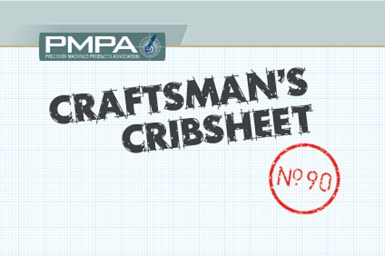The Most Common Types of Finishing Services for Precision Machined Components - Part 1 of 2
Cribsheet provided by PMPA member, Pioneer Service Inc. in Addison, Illinois

There are a variety of surface finishing techniques that add to or alter the surface layer of metal for a precision turned component. These finishing techniques can be utilized for aesthetic reasons, to protect the part from environmental factors or to improve the function of the part.
Bead Blast

Bead Blast
Bead blasting the surface of a precision machined component creates a uniform matte (satin) finish and removes the tool marks that are often visible from the machining process. This is often used when the component will be visible. As the name suggests, the component is blasted with small beads from a pressurized gun. The process removes some material and leaves a smooth surface.
Black Oxide

Black Oxide
Black oxide is a conversion coating which turns the surface of the precision machined component black. It is used for mild corrosion resistance, to minimize light reflection and often for appearance. Many parts for the firearms industry require a black oxide finish to reduce light reflection.
Burnishing
Burnishing is a forming process that alters the surface finish, size or surface hardness of a precision machined component and creates a mirror finish. It can be used to improve corrosion resistance, eliminate surface porosity, reduce fatigue failure and reduce surface visual defects. In the process, a hardened and coated ball or roller are run over the surface of the component to deform (or shape) it to the specified requirement.
Case Hardening

Case Hardening
Case hardening is a process to harden the surface of a metal component, while leaving the interior (core) metal at its original, softer state. This allows the core of the component to absorb stresses, but the outer surface to have improved wear resistance. There are several different types of case hardening processes, depending on the material and requirements. The most common types of case hardening for precision machined components include flame hardening, carburizing and nitriding. Flame hardening is the most common and heats the component (or bar stock) rapidly to a specified temperature and then cools it rapidly, creating a layer of martensite on the surface.
Diffusion Processes:
-
Carburizing. A type of case hardening process where the steel component is put in a carbon rich vacuum tank that elevates the temperature for a certain amount of time before quenching the part so that carbon is locked into the structure, creating a hardened surface.
-
Nitriding. In this process, the steel part is heated to a high level in a tank with ammonia gas for a specified amount of time. Nitrides form on the surface, creating a hardened surface. No quenching is needed with this process. Nitriding causes the least amount of distortion, but also requires the steel to have chromium, molybdenum and aluminum in its makeup.
Related Content
-
Machining Unleaded Materials — Reliability is Possible
Leaded steel is no longer produced in the United States. How do shops approach unleaded brass and steel machining?
-
Precision Ground Barstock: How It Is Manufactured, Benefits to Your Shop
Understanding the benefits provided by precision centerless ground barstock can help you avoid false economy and optimize the work you quote by maximizing benefits to your manufacturing process and customer.
-
Cold-Drawn Steel Barstock: How It Is Manufactured, Benefits to Your Shop
Understanding the benefits provided by cold-drawn steel barstock can help you optimize the work you quote by maximizing benefits to your manufacturing process and customer.















